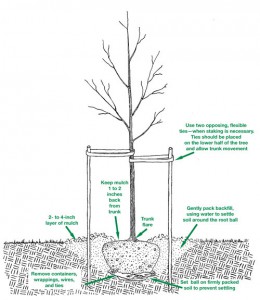 The best-known planting procedures will not save a tree that is poorly suited for its site. If trees can not tolerate site conditions they become stressful and more acceptable to many pests and diseases. One of the best ways to deter this is in the planting process. A tree planted in the right site will have an easier transition into its new environment and influence the long-term performance. When planting, it is important to remember that flooded and compact soil causes lack of oxygen causing trees to use respiration and its reserves. Trees that are not corrected from this environment are susceptible to possible death.
The best-known planting procedures will not save a tree that is poorly suited for its site. If trees can not tolerate site conditions they become stressful and more acceptable to many pests and diseases. One of the best ways to deter this is in the planting process. A tree planted in the right site will have an easier transition into its new environment and influence the long-term performance. When planting, it is important to remember that flooded and compact soil causes lack of oxygen causing trees to use respiration and its reserves. Trees that are not corrected from this environment are susceptible to possible death.
Once you have decided what species to purchase, take the time to examine the trees trunk and roots. A damaged trunk can lead to decay and disrupt vascular system flow; it can also be an entry site for insects and disease. When examining the roots, be sure to look for healthy roots which will be a white or light tan colour. Avoid roots that en-circle the trunk. Check to see if the overall tree is solid with little or no movement at the trunk. Be sure to take these steps when selecting your tree, to give it every advantage and avoid any unnecessary stress.
When to Plant
Deciduous tree must be planted in the spring as soon as frost is out of the ground, or in fall from leaf-fall until freeze up. Poplars, willows, ash, elms, and birches tend to over-winter better if planted in spring. Conifers can be planted in early spring up until four weeks after deciduous trees have opened their leaves. In the fall, plant first week of August to the end of October.
There are many important steps when choosing and planting trees or shrubs. Our staff have the knowledge to help you choose what is suitable. We can also prepare the tree or shrub for planting and the proper size hole and methods which will ensure roots have easy penetration and transitions into their new environment.
How to Plant a Tree Properly
- Dig a shallow, broad planting hole. Make the hole wide, as much as three times the diameter of the root ball but only as deep as the root ball. It is important to make the hole wide because the roots on the newly establishing tree must push through surrounding soil in order to establish. On most planting sites in new developments, the existing soils have been compacted and are unsuitable for healthy root growth. Breaking up the soil in a large area around the tree provides the newly emerging roots room to expand into loose soil to hasten establishment.
- Identify the trunk flare. The trunk flare is where the roots spread at the base of the tree. This point should be partially visible after the tree has been planted (see diagram). If the trunk flare is not partially visible, you may have to remove some soil from the top of the root ball. Find it so you can determine how deep the hole needs to be for proper planting.
- Remove tree container for containerized trees. Carefully cutting down the sides of the container may make this easier. Inspect the root ball for circling roots and cut or remove them. Expose the trunk flare, if necessary.
- Place the tree at the proper height. Before placing the tree in the hole, check to see that the hole has been dug to the proper depth’Äîand no more. The majority of the roots on the newly planted tree will develop in the top 12 inches of soil. If the tree is planted too deeply, new roots will have difficulty developing because of a lack of oxygen. It is better to plant the tree a little high, 2 to 3 inches above the base of the trunk flare, than to plant it at or below the original growing level. This planting level will allow for some settling (see diagram). To avoid damage when setting the tree in the hole, always lift the tree by the root ball and never by the trunk.
- Straighten the tree in the hole. Before you begin backfilling, have someone view the tree from several directions to confirm that the tree is straight. Once you begin backfilling, it is difficult to reposition the tree.
- Fill the hole gently but firmly. Fill the hole about one-third full and gently but firmly pack the soil around the base of the root ball. Then, if the root ball is wrapped, cut and remove any fabric, plastic, string, and wire from around the trunk and root ball to facilitate growth (see diagram). Be careful not to damage the trunk or roots in the process.
- Stake the tree, if necessary. If the tree is grown and dug properly at the nursery, staking for support will not be necessary in most home landscape situations. Studies have shown that trees establish more quickly and develop stronger trunk and root systems if they are not staked at the time of planting. However, protective staking may be required on sites where lawn mower damage, vandalism, or windy conditions are concerns. If staking is necessary for support, there are three methods to choose among: staking, guying, and ball stabilizing. One of the most common methods is staking. With this method, two stakes used in conjunction with a wide, flexible tie material on the lower half of the tree will hold the tree upright, provide flexibility, and minimize injury to the trunk (see diagram). Remove support staking and ties after the first year of growth.
- Mulch the base of the tree. Mulch is simply organic matter applied to the area at the base of the tree. It acts as a blanket to hold moisture, it moderates soil temperature extremes, and it reduces competition from grass and weeds. Some good choices are leaf litter, pine straw, shredded bark, peat moss, or composted wood chips. A 2- to 4-inch layer is ideal. More than 4 inches may cause a problem with oxygen and moisture levels. When placing mulch, be sure that the actual trunk of the tree is not covered. Doing so may cause decay of the living bark at the base of the tree. A mulch-free area, 1 to 2 inches wide at the base of the tree, is sufficient to avoid moist bark conditions and prevent decay.
- Provide follow-up care. Keep the soil moist but not soaked; overwatering causes leaves to turn yellow or fall off. Water trees at least once a week, barring rain, and more frequently during hot weather. When the soil is dry below the surface of the mulch, it is time to water. Continue until mid-fall, tapering off for lower temperatures that require less-frequent watering.Other follow-up care may include minor pruning of branches damaged during the planting process. Prune sparingly immediately after planting and wait to begin necessary corrective pruning until after a full season of growth in the new location.
After you have completed these nine simple steps, further routine care and favorable weather conditions will ensure that your new tree or shrub will grow and thrive. A valuable asset to any landscape, trees provide a long-lasting source of beauty and enjoyment for people of all ages. When questions arise about the care of your tree, be sure to consult your local ISA Certified Arborist or a tree care or garden center professional for assistance.

